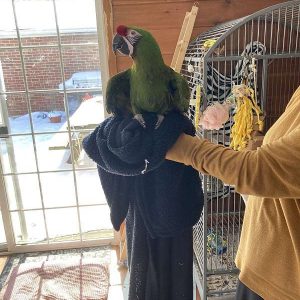Green Winged Macaw (BRUCE)
Green Winged Macaw (BRUCE) also know as the red and green  is a large bird. It is of the genus ara and belongs to the macaw species. The Green-winged Macaw sometimes loses tiny red feathers around the face. Typical of an ara is the strong and large bill. Its strong toes are grey. Gender can’t be told easily because females and males don’t differ in their appearance.
is a large bird. It is of the genus ara and belongs to the macaw species. The Green-winged Macaw sometimes loses tiny red feathers around the face. Typical of an ara is the strong and large bill. Its strong toes are grey. Gender can’t be told easily because females and males don’t differ in their appearance.
The green-winged macaw is a large parrot covered with mostly red plumage. The wing and tail feathers are blue and green, hence its name. This macaw has a white naked face, striped with small red feathers.
Green-winged macaws, also known as red-and-green macaws, are large, colorful, and social parrots that make wonderful pets for experienced bird owners. Here’s a guide on how to buy one
2. Where to Buy
- Reputable Breeders: Look for breeders who specialize in macaws. They should provide health records, information about the bird’s lineage, and allow visits.
- Adoption/Rescue Centers: Many macaws in need of homes are available at avian rescues. This is often more affordable and humane.
- Exotic Pet Stores: Choose stores that demonstrate ethical practices and care for their birds.
1. Research Reputable Breeders or Sellers
- Look for breeders or aviaries specializing in macaws. Reputable breeders ensure the birds are healthy, socialized, and ethically bred.
- Online directories like BirdBreeders.com or The Finch Farm often list macaws for sale.
2. Exotic Pet Shops
- Visit well-reviewed exotic pet shops. Ensure they have proper certifications and prioritize animal welfare.
3. Adoption Options
- Check animal shelters or exotic bird rescues. Many Green-Winged Macaws need rehoming, and adoption can be a rewarding option.
4. Legal and Ethical Considerations
- Verify local regulations about owning exotic birds. Some areas require permits.
- Ensure the seller provides paperwork proving the bird is captive-bred (not wild-caught).
5. Cost and Care Commitment
- Price: Green-Winged Macaws typically cost between $3,000 and $5,000.
- Care: They require a spacious cage, a balanced diet (pellets, fruits, vegetables), regular vet check-ups, and significant interaction to stay mentally stimulated.






